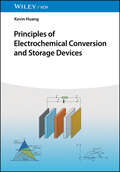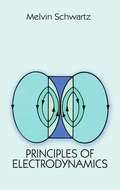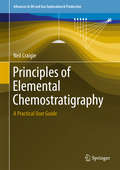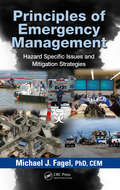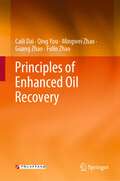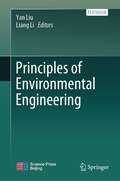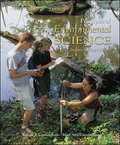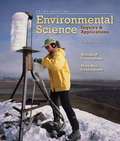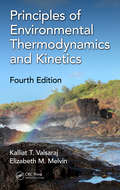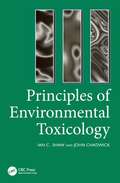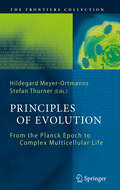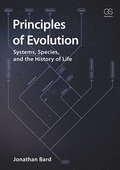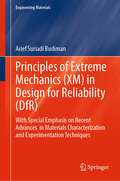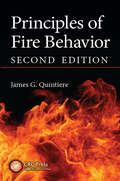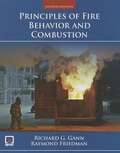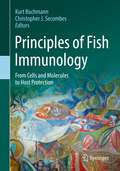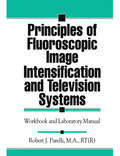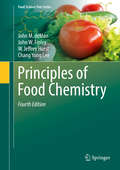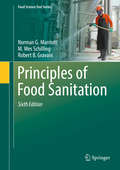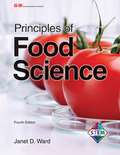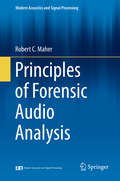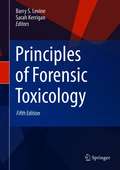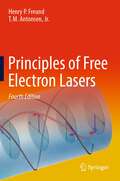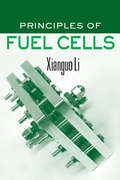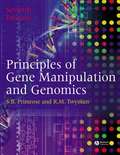- Table View
- List View
Principles of Electrochemical Conversion and Storage Devices
by Kevin HuangComprehensive resource covering fundamental principles of electrochemical energy conversion and storage technologies including fuel cells, batteries, and capacitors Starting with the importance and background of electrochemical foundations, Principles of Electrochemical Conversion and Storage Devices explains the working principles and electrochemistry of electrochemical cells. After a summary of thermodynamic and kinetics, different types of fuel cells as well as batteries and capacitors are covered. This book is written in the style of a textbook, providing illustrative examples and inspiring problems to facilitate the understanding of essential principles of electrochemical cells while offering practical insights for research pursuits. Various application examples are provided at the end of each chapter to strengthen reader understanding of energy storage from a practical point of view. Written by a highly qualified and awarded academic and based on a culmination of his two decades of personal teaching and research experience in the field, Principles of Electrochemical Conversion and Storage Devices includes information on: Common reference electrodes and potentials, standard electrode potentials in aqueous solutions, and current functions for the charge transfer processStandard Gibbs free energy of formation of selected compounds, standard heat of combustion of common fuels, and commonly used physical constantsLatest developments in the field, especially surrounding clean energy technologies, and various experimental methods essential for conducting rigorous electrochemical researchCharacterizing methods, key materials, and governing principles behind all of the covered devices Providing comprehensive coverage of the subject, Principles of Electrochemical Conversion and Storage Devices is an excellent resource tailored for researchers and students from all technical and natural science disciplines seeking to understand more about the most promising energy-related devices and the potential they hold to change the world.
Principles of Electrodynamics
by Melvin SchwartzUnlike most textbooks on electromagnetic theory, which treat electricity, magnetism, Coulomb's law and Faraday's law as almost independent subjects within the framework of the theory, this well-written text takes a relativistic point of view in which electric and magnetic fields are really different aspects of the same physical quantity.Suitable for advanced undergraduates and graduate students, this volume offers a superb exposition of the essential unity of electromagnetism in its natural , relativistic framework while demonstrating the powerful constraint of relativistic invariance. It will be seen that all electromagnetism follows from electrostatics and from the requirement for the simplest laws allowable under the relativistic constraint. By means of these insights, the author hopes to encourage students to think about theories as yet undeveloped and to see this model as useful in other areas of physics.After an introductory chapter establishing the mathematical background of the subject and a survey of some new mathematical ideas, the author reviews the principles of electrostatics. He then introduces Einstein's special theory of relativity and applies it throughout the rest of the book. Topics treated range from Gauss's theorem, Coulomb's law, the Faraday effect and Fresnel's equations to multiple expansion of the radiation field , interference and diffraction, waveguides and cavities and electric and magnetic susceptibility.Carefully selected problems at the end of each chapter invite readers to test their grasp of the material. Professor Schwartz received his Ph.D. from Columbia University and has taught physics there and at Stanford University. He is perhaps best known for his experimental research in the field of high-energy physics and was a co-discoverer of the muon-type neutrino in 1962. He shared the 1988 Nobel Prize in Physics with Leon M. Lederman and Jack Steinberger.
Principles of Elemental Chemostratigraphy
by Neil CraigieThis book provides the reader with a comprehensive understanding of the applications of chemostratigraphy. The first chapter of the book offers an introduction to the technique. This is followed by a chapter detailing sample preparation and analytical techniques. Chapter 3 focuses on the techniques utilised to establish the mineralogical affinities of elements, while the general principles of how to build a chemostratigraphic scheme are covered in Chapter 4. Chapters 5, 6 and 7 provide information on the applications of chemostratigraphy to clastic, carbonate and unconventional reservoirs respectively, and various case studies are presented. Wellsite applications, a discussion and conclusion section form the latter part of the book.The book will appeal to graduate and post graduate students of geology and professionals working in the hydrocarbon sector as a key reference text in chemostratigraphy.
Principles of Emergency Management: Hazard Specific Issues and Mitigation Strategies
by Michael J. FagelPrinciples of Emergency Management: Hazard Specific Issues and Mitigation offers preparedness and mitigation recommendations for advanced emergency planning. Because disasters are so unpredictable, advance planning is needed to effectively respond to and mitigate against the potential effects of such events.Whether a disaster is natural or man-made
Principles of Enhanced Oil Recovery
by Caili Dai Fulin Zhao Qing You Mingwei Zhao Guang ZhaoThis book presents the latest progress in enhanced oil recovery technology and introduces the application of various enhanced oil recovery methods in oilfield development. Enhanced oil recovery (EOR) is a continuous theme in oilfield development. Due to the influence of geological conditions, development mode and physical and chemical factors, more than half of the proven oil reserves remain underground and cannot be accessed. Therefore, many enhanced oil recovery methods have been developed to achieve higher oil recovery. This book presents the basic principles and provides the chemistry knowledge related to enhanced oil recovery. It also expounds the applicable criteria of chemical agents. In addition, combined with field application examples, the limitations of existing enhanced oil recovery methods are analyzed, and the future development direction of enhanced oil recovery technology is highlighted. It is worth noting that the integral profile control and water shutoff technology in this book is widely recognized in the enhanced oil recovery industry and has achieved remarkable economic benefits. Given its scope, this book is useful for the scientific and technical personnel engaged in the study of oil recovery chemistry and enhanced oil recovery and also as a teaching reference for teachers and students majoring in petroleum engineering and oilfield chemistry.
Principles of Environmental Engineering
by Yan Liu Liang LiThis textbook contains the contents coming from hydraulics, hydrodynamics, chemical principles, chemical reaction engineering and bioengineering, which relates closely with fundamental principles in environmental engineering. It mainly covers principles including basic concepts, theories, methods and related equipment in fluid flow and transportation, heat transfer, absorption, chemical and biological reaction kinetics and reactors, as well as their applications in environmental engineering. At same time, the readers learns the basic viewpoints and methods commonly used in engineering technology, such as balance method, reasonable simplification, dimensional analysis method, boundary layer theory, optimization and mathematical model method. It broadens the student’s understanding in solving those problems in environmental engineering, and enhances their awareness of industrialization. This book is the specialized foundation and principles for learning the professional courses of environmental engineering, such as "water pollution control," "air pollution control," "solid waste treatment and disposal" and "ecological restoration engineering", while avoiding the repetition of the contents of those professional books.
Principles of Environmental Science: Inquiry & Applications (Fourth Edition)
by William P. Cunningham Mary Ann CunninghamPrinciples of Environmental Science deals with issues honestly and openly, with a balanced, objective perspective that presents both sides of controversial issues. This book provides a solid foundation in scientific approaches to environmental problems and solutions.
Principles of Environmental Science: Inquiry and Applications (6th Edition)
by William P. Cunningham Mary Ann CunninghamThis concise text provides an up-to-date, introductory view of essential themes in environmental science along with offering students numerous opportunities to practice scientific thinking and active learning.
Principles of Environmental Thermodynamics and Kinetics, Fourth Edition
by Kalliat T. Valsaraj Elizabeth M. MelvinThis book is about applications of chemical thermodynamics and kinetics to various environmental problems related to air, water, soil, and biota. The new edition contains substantial updates and a new table of contents. The applications are new and extended to include current events in environmentally-based challenges. Demonstrates the theoretical foundations of chemical property estimations for environmental process modeling. Provides a thorough understanding of applications and limitations of various property correlations. It adopts a multimedia approach to fate and transport modeling and pollution control design options. Includes numerous worked-out examples and hundreds of problems.
Principles of Environmental Toxicology
by J. Chadwick I. ShawEnvironmental toxicology is the study of the action of chemicals upon ecosystems. Understanding the effects of exogenous chemicals upon the inhabitants of an ecosystem may enable us to predict and possibly prevent their deleterious effects. This textbook provides a good general introduction to all the major areas of environmental toxicology, including the fate of chemicals in the environment, environmental toxicity testing, risk assessment, radioactivity in the environment, legislation, environmental monitoring and the future impact of industrial development on the environment. It is written in an informal, accessible style with many examples of environmental issues taken from the author's personal experience and will provide students and other interested individuals with a broad overview of the science of environmental toxicology.
Principles of Evolution
by Hildegard Meyer-Ortmanns Stefan ThurnerWith contributions from a team of leading experts, this volume provides a comprehensive survey of recent achievements in our scientific understanding of evolution. The questions it asks concern the beginnings of the universe, the origin of life and the chances of its arising at all, the role of contingency, and the search for universal features in the plethora of evolutionary phenomena. Rather than oversimplified or premature answers, the chapters provide a clear picture of how these essential problems are being tackled, enabling the reader to understand current thinking and open questions. The tools employed stem from a range of disciplines including mathematics, physics, biochemistry and cell biology. Self-organization as an overarching concept is demonstrated in the most diverse areas: from galaxy formation in the universe to spindle and aster formation in the cell. Chemical master equations, population dynamics, and evolutionary game theory are presented as suitable frameworks for understanding the universal mechanisms and organizational principles observed in a wide range of living units, ranging from cells to societies. This book will provide engaging reading and food for thought for all those seeking a deeper understanding of the science of evolution.
Principles of Evolution: Systems, Species, and the History of Life
by Jonathan BardPrinciples of Evolution considers evolution in the context of systems biology, a contemporary approach for handling biological complexity. Evolution needs this systems perspective for three reasons. First, most activity in living organisms is driven by complex networks of proteins and this has direct implications, particularly for understanding evo-devo and for seeing how variation is initiated. Second, it provides the natural language for discussing phylogenetic trees. Third, evolutionary change involves events at levels ranging from the genome to the ecosystem and systems biology provides a context for integrating material of this complexity. Understanding evolution means, on the one hand, describing the history of life and, on the other, making sense of the principles that drove that history. The solution adopted here is to make the science of evolution the primary focus of the book and place the various parts of the history of life in the context of the research that unpicks it. This means that the history is widely distributed across the text. This concise textbook assumes that the reader has a fair amount of biological knowledge and gives equal weight to all the major themes of evolution: the fossil record, phylogenetics, evodevo, and speciation. Principles of Evolution will therefore be an interesting and thought-provoking read for honors-level undergraduates, and graduates working in the biological sciences.
Principles of Extreme Mechanics: With Special Emphasis on Recent Advances in Materials Characterization and Experimentation Techniques (Engineering Materials)
by Arief Suriadi BudimanThis book addresses issues pertinent to mechanics and stress generation, especially in recent advanced cases of technology developments, spanning from micrometer interconnects in solar photovoltaics (PV), next-gen energy storage devices to multilayers of nano-scale composites enabling novel stretchable/flexible conductor technologies. In these cases, the mechanics of materials have been pushed to the extreme edges of human knowledge to enable cutting-edge, unprecedented functionalities and technological innovations. Synchrotron X-ray diffraction, in situ small-scale mechanical testing combined with physics-based computational modeling/simulation, has been widely used approaches to probe these mechanics of the materials at their extreme limits due to their recently discovered distinct advantages. The techniques discussed in this manuscript are highlights specially curated from the broad body of work recently reported in the literature, especially ones that the author had led the pursuits at the frontier himself. Extreme stress generation in these advanced material leads to often new failure modes, and hence, the reliability of the final product is directly affected. From the recent topics and various advanced case studies covered in this book, the reader gets an updated knowledge of how new mechanics can and has been applied in Design-for-Reliability (DfR) for some of the latest technological innovations known in our modern world. Further, this also helps in building better designs, which may avoid the pitfalls of the current practiced trends.
Principles of Fire Behavior (Career Education Ser.)
by James G. QuintiereThis text covers the four forms of fire: diffusion flames, smoldering, spontaneous combustion, and premixed flames. Using a quantitative approach, the text introduces the scientific principles of fire behavior, with coverage of heat transfer, ignition, flame spread, fire plumes, and heat flux as a damage variable. Cases, examples, problems, selected color illustrations and review of mathematics help students in fire safety and investigation understand fire from a scientific point of view.
Principles of Fire Behavior and Combustion (Fourth Edition)
by Richard G. Gann Raymond FriedmanThis expanded edition addresses all the course objectives and learning outcomes for the National Fire Academy FESHE Model Curriculum Associate's (Core) course called Fire Behavior and Combustion.
Principles of Fish Immunology: From Cells and Molecules to Host Protection
by Kurt Buchmann Christopher J. SecombesThis textbook provides a highly accessible and concise overview on the innate and adaptive immune systems in fish as well as on fundamentals and latest developments in fish vaccinology. It introduces the anatomy and molecular functions of immune organs and furthermore examines in detail the interactions between the host immune systems and different types of pathogens.The textbook is essential reading for students in Veterinary/Fish Medicine, Aquaculture and Immunology. Furthermore, the volume serves as a quick reference for Fish Pathologists and Aquaculturists.Chapter 2 is available open access under a Creative Commons Attribution 4.0 International License via link.springer.com.
Principles of Fluoroscopic Image Intensification and Television Systems: Workbook and Laboratory Manual
by Robert J. ParelliThis unique workbook can be used as a stand-alone text or supplemental text for any course designed to enhance the work of radiologic technology students. It will also serve the needs of graduate radiographers as well as the physician in learning specific areas of the Fluoroscopic Image Intensifier such as:
Principles of Food Chemistry (Food Science Text Series)
by John M. DeMan John W. Finley W. Jeffrey Hurst Chang Yong LeeCompletely revised, this new edition updates the chemical and physical properties of major food components including water, carbohydrates, proteins, lipids, minerals vitamins and enzymes. Chapters on color, flavor and texture help the student understand key factors in the visual and organoleptic aspects of food. The chapter on contaminants and additives provides an updated view of their importance in food safety. Revised chapters on beer and wine production, and herbs and spices, provide the student with an understanding of the chemistry associated with these two areas which are growing rapidly in consumer interest. New to this edition is a chapter on the basics of GMOs. Each chapter contains new tables and illustrations, and an extensive bibliography, providing readers with ready access to relevant literature and links to the internet where appropriate. Just like its widely used predecessors, this new edition is valuable as a textbook and reference.
Principles of Food Sanitation (Food Science Text Ser.)
by Robert B. Gravani Norman G. Marriott M. Wes SchillingNow in its 6th Edition, this highly acclaimed textbook provides sanitation information needed to ensure hygienic practices and safe food for food industry personnel as well as students. It addresses the principles related to contamination, cleaning compounds, sanitizers, cleaning equipment. It also presents specific directions for applying these concepts to attain hygienic conditions in food processing or food preparation operations.New in this edition: Updated chapters on the fundamentals of food sanitation, contamination sources and hygiene, Hazard Analysis Critical Control Points, cleaning and sanitizing equipment, waste handling disposal, biosecurity, allergens, quality assurance, pest control, cleaning compound and sanitizer properties and selection criteria, hygienic construction, sanitation guidelines for food and foodservice establishments, and sanitation management principles.
Principles of Forensic Audio Analysis (Modern Acoustics and Signal Processing)
by Robert C. MaherThis book provides an expert introduction to audio forensics, an essential specialty in modern forensic science, equipping readers with the fundamental background necessary to understand and participate in this exciting and important field of study. Modern audio forensic analysis combines skills in digital signal processing, the physics of sound propagation, acoustical phonetics, audio engineering, and many other fields. Scientists and engineers who work in the field of audio forensics are called upon to address issues of authenticity, quality enhancement, and signal interpretation for audio evidence that is important to a criminal law enforcement investigation, an accident investigation board, or an official civil inquiry.Expertise in audio forensics has never been more important. In addition to routine recordings from emergency call centers and police radio dispatchers, inexpensive portable audio/video recording systems are now in widespread use. Forensic evidence from the scene of a civil or criminal incident increasingly involves dashboard recorders in police cars, vest-pocket personal recorders worn by law enforcement officers, smart phone recordings from bystanders, and security surveillance systems in public areas and businesses. Utilizing new research findings and both historical and contemporary casework examples, this book blends audio forensic theory and practice in an informative and readable manner suitable for any scientifically-literate reader. Extensive examples, supplementary material, and authoritative references are also included for those who are interested in delving deeper into the field.
Principles of Forensic Toxicology
by Barry S. Levine Sarah KerriganThe fifth edition of the best-selling Principles in Forensic Toxicology continues in the tradition of excellence in academic publishing. With over 10 years of classroom-tested and continually updated content, the new edition contains significant updates and 7 new chapters on new topics including drug-facilitated crimes, derivatization, quantitation, measurement uncertainty/traceability, statistics, oral fluid testing, and drugs in embalmed specimens. Part One covers the major sub-disciplines of forensic toxicology in addition to pharmacological concepts. Part Two addresses specimen preparation, laboratory testing and instrumental analysis, while Part Three discusses common analytes including cocaine, opioids, alcohol, and marijuana. Adopted for courses in many of the top universities for forensic science and used by respected medical examiner’s offices and crime laboratories worldwide, Principles of Forensic Toxicology prepares the next generation of forensic toxicologists and continues to be an important reference in professional practice.
Principles of Free Electron Lasers
by Henry P. Freund T.M. Antonsen, Jr.This book presents a comprehensive description of the physics of free-electron lasers starting from the fundamentals and proceeding through detailed derivations of the equations describing electron trajectories, and spontaneous and stimulated emission. Linear and nonlinear analyses are described, as are detailed explanations of the nonlinear simulation of a variety of configurations including amplifiers, oscillators, self-amplified spontaneous emission, high-gain harmonic generation, and optical klystrons. Theory and simulation are anchored using comprehensive comparisons with a wide variety of experiments.
Principles of Fuel Cells
by Xianguo LiThe book is engineering oriented and covers a large variety of topics ranging from fundamental principles to performance evaluation and applications. It is written systematically and completely on the subject with a summary of state-of-the-art fuel cell technology, filling the need for a timely resource. This is a unique book serving academic researchers, engineers, as well as people working in the fuel cell industry. It is also of substantial interest to students, engineers, and scientists in mechanical engineering, chemistry and chemical engineering, electrochemistry, materials science and engineering, power generation and propulsion systems, and automobile engineering.
Principles of Gene Manipulation and Genomics
by Richard Twyman Sandy B. PrimroseThe increasing integration between gene manipulation and genomics is embraced in this new book, Principles of Gene Manipulation and Genomics, which brings together for the first time the subjects covered by the best-selling books Principles of Gene Manipulation and Principles of Genome Analysis & Genomics. Comprehensively revised, updated and rewritten to encompass within one volume, basic and advanced gene manipulation techniques, genome analysis, genomics, transcriptomics, proteomics and metabolomics Includes two new chapters on the applications of genomics An accompanying website - www.blackwellpublishing.com/primrose - provides instructional materials for both student and lecturer use, including multiple choice questions, related websites, and all the artwork in a downloadable format. An essential reference for upper level undergraduate and graduate students of genetics, genomics, molecular biology and recombinant DNA technology.
